Future Workers of Indiana: Projecting the Labor Force to 2040
Like much of the United States, Indiana experienced dynamic growth in the size of its labor force during the last half of the 20th century.1 Spurred by the entrance of baby boomers into the workforce and increasing labor force participation by women, Indiana’s labor force doubled from 1.57 million in 1950 to 3.12 million in 2000 (see Figure 1). The most dramatic jump in Indiana’s labor force occurred during the 1970s when the state added more than 460,000 workers. Labor force growth slowed during the difficult 1980s but rebounded strongly the following decade.
Figure 1: Indiana Labor Force, 1940 to 2040
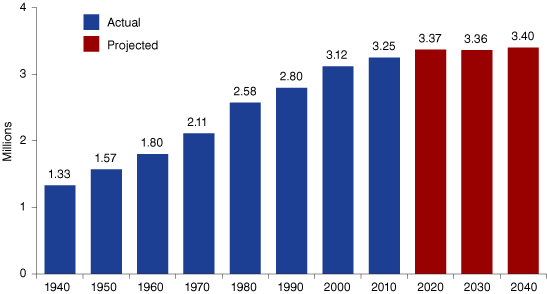
Note: Beginning in 1960, the Census Bureau defined the eligible labor force as the population age 16 and older. It was 14 and older prior to 1960.
Source: U.S. Census Bureau and Indiana Business Research Center
Between 2000 and 2010, however, Indiana’s labor force grew by only 132,000—its smallest gain over a decade since the Census Bureau began collecting data on the size of the labor force in 1940. While the recent economic slump may have contributed to this lackluster performance, labor force projections produced for the Indiana Department of Workforce Development by the Indiana Business Research Center (IBRC) indicate that this slowdown is less a byproduct of the Great Recession and more likely a harbinger of continued slow growth in the coming decades (see Figure 2).
Figure 2: Indiana Labor Force Change, 1940 to 2040
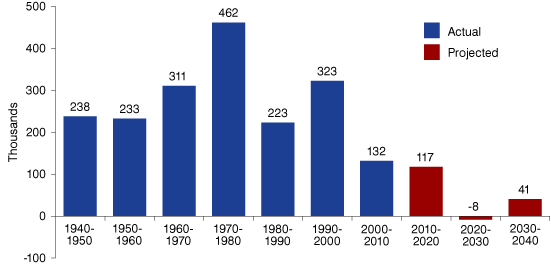
Source: U.S. Census Bureau and Indiana Business Research Center
Labor force change in the state is expected to slow to less than 120,000 in this decade and will be essentially flat between 2020 and 2030—a decade during which the entire baby boom cohort will have reached traditional retirement age. Indiana’s labor force will likely begin to grow again—albeit slowly— after 2030. To help put this shift into perspective: Indiana’s labor force grew by an average of 310,000 per decade between 1950 and 2000. However, over the next three decades combined, Indiana’s total labor force growth is expected to be 150,000.
This article examines the critical factors that shape Indiana’s labor force such as population growth and labor force participation rates. Later, we focus on the expected trends for Indiana counties and metropolitan areas. Finally, we hone in on implications that this dramatic shift may have on the state’s economy.
Drivers of Labor Force Change
Demographic trends and labor force participation are the primary drivers of labor force change. As such, the one-two punch of the large baby boom cohort and an ever-increasing share of women entering the workplace fueled the remarkable labor force growth between 1950 and 2000.
The dramatic change in the number of births at the national level during the baby boom years can be seen in figure 3. Between 1925 and 1945, the U.S. averaged 2.6 million births per year. The average annual mark jumped to 4.0 million between 1946 and 1964 but fell again to 3.4 million per year during the so-called baby bust (1965 to 1979). Fertility rates have remained relatively low since, but the annual number of births has generally increased at a steady rate due to factors like boomers having their own children and immigration. In fact, the U.S. set a new record for the annual number of births in 2007, breaking a mark previously set in 1957. However, births have declined sharply since the economic downturn.
Figure 3: Births and Fertility Rate in the United States, 1925 to 2010
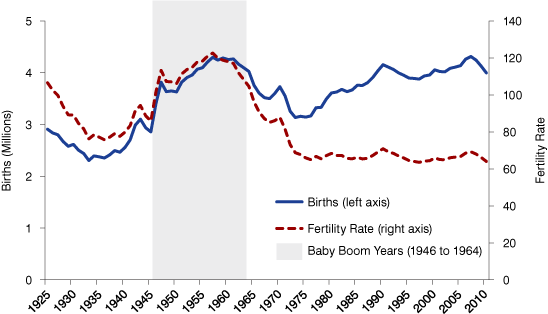
Note: The fertility rate is expressed as the number of births per 1,000 women aged 15-44 years.
Source: National Center for Health Statistics, Centers for Disease Control and Prevention
Birth data at the state level do not extend back to the baby boom era, but a look at Indiana’s population by year of birth indicates that the state has had a similar demographic ebb and flow. As of the 2010 census, the number of Hoosiers born between 1950 and 1964 outnumber those born during the subsequent 15-year period by nearly 117,000. Adding to Indiana’s labor force lag, the state’s baby bust effectively extended into the late 1980s due to a period of strong net out-migration from Indiana over much of that decade. In 2010, only Hoosier cohorts born between 1988 and 1991 were as large as those from the peak of the baby boom (see Figure 4). The IBRC projects that the number of births in Indiana will rise modestly over the next few decades. However, this increase will not be large enough to alter labor force growth dramatically.2
Figure 4: Population by Year of Birth in the United States and Indiana, 2010
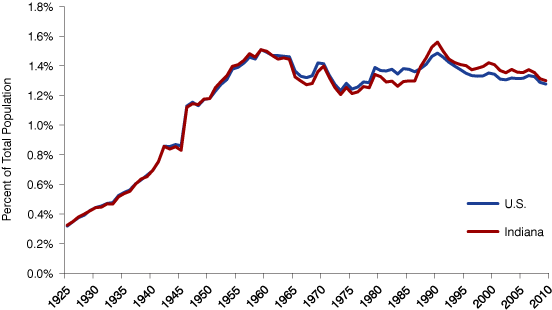
Source: U.S. Census Bureau
Figure 5 highlights the dramatic influx of female workers to Indiana’s labor force before the turn of the century. Indiana’s female labor force participation rate (LFPR)—the share of population age 16 or older that are in the labor force—increased from 27.6 percent in 1950 to 60.0 percent in 2000. Given that the population was also climbing over this period, the increase in female LFPR translates to an increase in female workers from 410,700 to 1.45 million. This momentous shift helped boost Indiana’s total LFPR 13 percentage points to 66.6 percent in 2000, even as the male LFPR was declining from 80.0 percent to 73.7 percent over the same period.
Figure 5: Indiana Labor Force Participation Rate, 1940 to 2040
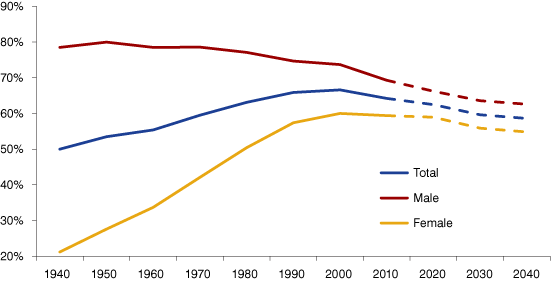
Note: Dashed lines represent projected values.
Source: U.S. Census Bureau and Indiana Business Research Center
Total and female LFPRs appear to have peaked somewhere around the year 2000. Over the past decade, Indiana’s female LFPR ticked down by 0.6 percentage points while the mark for males dropped by more than 4 points. In all, Indiana’s total LFPR dropped 2.4 percentage points to 64.2 percent between 2000 and 2010.
Since the total LFPR calculation uses the entire population age 16 or older as its denominator, a decline in this measure was inevitable as the population aged and more boomers retired. Back in 2006, the U.S. Bureau of Labor Statistics (BLS) was already projecting that the nation’s LFPR would decline by 1.2 points between 2000 and 2010.3 As it turned out, the U.S. LFPR declined by 2.4 percentage points (to 64.7 percent) last decade—a mark that was identical to Indiana’s drop.
This unexpectedly severe decline in LFPR reflects both demographic trends and the impact of the Great Recession. There is no consensus as to how much of this decline is attributable to demographics versus cyclical factors, but various analyses claim that the recession accounts for anywhere from one-third to one-half of the recent drop in LFPR.4 If so, participation could rebound some in the near-term if the labor market heats up. That said, both Indiana’s and the United States’ total LFPR will continue sliding in the long run as the population ages. The IBRC projections indicate that Indiana’s LFPR will decline to 58.6 percent by 2040.
Different waves of migration have also contributed to the state’s labor force growth. Between 1940 and 1970, the so-called Great Migration involved the movement of black Americans from the south to new homes in the north and the west. Over this period, Indiana cities like Gary, South Bend and Fort Wayne had some of the fastest black population growth rates among the country’s bigger cities.5 In all, Indiana’s black population increased nearly threefold—from 121,900 to 357,500—during these years.
Indiana had a net out-migration of residents during the 1970s and 1980s but the 1990s featured another surge in movement to the state. According to data from Moody’s Economy.com, Indiana had a net influx of more than 200,000 residents during the 1990s. New Hispanic residents to the state no doubt spurred a good portion of this inflow as the size of this population in Indiana more than doubled over the decade. Net in-migration to the state dropped to roughly 80,000 between 2000 and 2010.6 The population projections used for this labor force analysis show that Indiana should expect a net inflow of residents to continue—although at ever-lower levels ranging from 65,000 between 2010 and 2020 to 47,000 over the 2030s.
Indiana’s Trend in Perspective
Perhaps the easiest way to think about how birth and participation trends shape Indiana’s labor force is this: women entering the workplace contributed greatly to the intensity of labor force growth between 1950 and 2000 but birth trends have largely defined the contours of change for the last half of the 20th century as well as the first half of this one. Absent a much larger than expected flow of migration into Indiana, there is no new source of labor available to offset the demographic shifts. That is why these projections indicate, for instance, that there will be no labor force growth in the state during the 2020s—a period during which the boom and bust generations will begin to find themselves on opposite sides of the traditional retirement age.
Of course, these trends are not unique to Indiana. Figure 6 shows that BLS expects a similar trend in labor force change nationally. U.S. labor force growth has outpaced Indiana’s for some time and will likely do so in the future. However, BLS projects that the nation’s average annual growth rate will slow to as low as 0.4 percent during the 2020s. Note that BLS released these projections in 2006—before the latest recession. Future growth rates for the nation may well be lower the next time BLS releases long-range projections.
Figure 6: Labor Force Growth Rates by Decade, Indiana and the United States, 1960 to 2040

Note: BLS labor force numbers for the U.S. cover the civilian noninstitutional population age 16+. The numbers for Indiana cover the entire population age 16+.
Source: U.S. Bureau of Labor Statistics, U.S. Census Bureau and Indiana Business Research Center
Labor Force by Age
While the total LFPR will decline over the next few decades because of population aging, most age-specific LFPRs are projected to increase, particularly for those age 55 and older. For instance, the LFPR for Hoosiers age 60 to 64 climbed 6.3 percentage points between 2000 and 2010 and is expected to rise another 4.8 points this decade (see Figure 7). The LFPR for the 65-to-69 age group is projected to increase by 4.5 points between 2010 and 2020, when nearly one-third of this age group will be in the labor force by the end of that period. An increased LFPR among older workers reflects many factors including improved health, the need to increase retirement savings and the gradually increasing full-retirement age for social security benefits— which current law states will increase from age 66 for today’s retirees to 67 for those born after 1959.
Figure 7: Indiana Labor Force Participation Rates by Age, 2000 to 2020

Source: U.S. Census Bureau and Indiana Business Research Center
LFPRs will also edge up over this decade in most of the prime working age groups with the exception of a slight decline in the 35-to-44 bracket. At the other end of the spectrum, participation among younger Hoosiers dropped sharply last decade and is expected to slide further. In 2000, roughly 57 percent of Indiana’s teens old enough to work were in the labor force. That number fell to 38.5 percent in 2010 and is expected to be 33.9 percent in 2020. The LFPR for Indiana’s 20-to-24 age group fell more than 5 percentage points last decade and is projected to decline slightly more in this decade.
Due to the declining LFPRs among younger Hoosiers, the labor force in the 16-to-24 age group declined by 64,000 between 2000 and 2010 even as the population in this age group grew by 45,000. The youth labor force is projected to decline slightly more by 2020 before beginning to tick up again simply because of population growth (see Figure 8).
Figure 8: Indiana Labor Force by Select Age Groups, 2000 to 2040
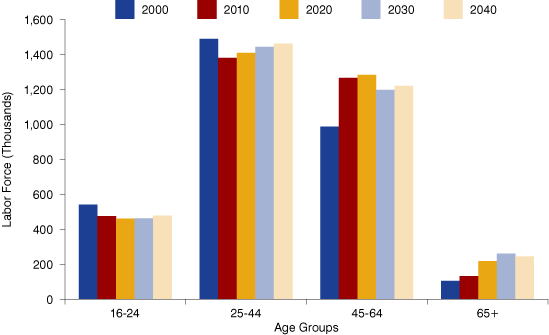
Source: U.S. Census Bureau and Indiana Business Research Center
The size of the labor force in the 25-to-44 group dropped last decade as the last half of the boomers aged out of this bracket. The numbers in this group will climb over the next three decades, averaging an increase of nearly 27,000 per decade. By 2010, the entire baby boom cohort was in the 45-to-64 age bracket, leading to a large jump in the size of this labor force category. This group will grow a bit more in this decade and then decline after 2020. The number of Hoosiers age 65 and older in the labor force will nearly double from 131,000 to 261,000 between 2010 and 2030 before declining some after that period. Over the next two decades, this age group will go from claiming 4 percent of Indiana’s labor force in 2010 to 7.7 percent in 2030.
Across Indiana
There are wide disparities in projected labor force change across Indiana’s regions. Seven of the state’s 16 metro areas are expected to exceed or match Indiana’s rate of labor force growth between 2010 and 2020 (see Table 1). Leading the way is the 10-county Indianapolis-Carmel metro, whose labor force is projected to grow by 1 percent per year in this decade. Other metros with relatively high projected growth rates through 2020 include Lafayette (0.6 percent per year), the Indiana portion of the Louisville metro (0.6 percent) and Elkhart-Goshen (0.5 percent). Each of these metros will have a lower rate of change between 2020 and 2030.
Table 1: Labor Force by Metro Area, 2000 to 2030
| Metro Area | Labor Force (thousands) | Average Annual Rate of Change | |||||
|---|---|---|---|---|---|---|---|
| 2000 | 2010 | 2020 | 2030 | 2000-10 | 2010-20 | 2020-30 | |
| Indiana Total | 3,120.9 | 3,253.0 | 3,370.3 | 3,362.2 | 0.4% | 0.4% | 0.0% |
| Anderson | 63.9 | 62.4 | 60.2 | 57.2 | -0.2% | -0.4% | -0.5% |
| Bloomington | 91.7 | 95.5 | 99.9 | 101.8 | 0.4% | 0.4% | 0.2% |
| Cincinnati-Middletown* | 38.0 | 40.6 | 41.4 | 39.7 | 0.7% | 0.2% | -0.4% |
| Columbus | 37.2 | 39.6 | 41.1 | 41.1 | 0.6% | 0.4% | 0.0% |
| Elkhart-Goshen | 96.5 | 98.8 | 103.4 | 105.2 | 0.2% | 0.5% | 0.2% |
| Evansville* | 148.5 | 153.5 | 155.3 | 152.1 | 0.3% | 0.1% | -0.2% |
| Fort Wayne | 207.0 | 209.2 | 217.7 | 218.3 | 0.1% | 0.4% | 0.0% |
| Gary | 329.9 | 343.2 | 349.8 | 344.9 | 0.4% | 0.2% | -0.1% |
| Indianapolis-Carmel | 809.8 | 920.9 | 1,020.8 | 1,074.0 | 1.3% | 1.0% | 0.5% |
| Kokomo | 50.0 | 44.7 | 41.9 | 38.3 | -1.1% | -0.6% | -0.9% |
| Lafayette | 95.9 | 103.7 | 109.9 | 112.6 | 0.8% | 0.6% | 0.2% |
| Louisville* | 121.3 | 131.7 | 139.2 | 140.9 | 0.8% | 0.6% | 0.1% |
| Michigan City-La Porte | 53.4 | 52.8 | 52.2 | 49.3 | -0.1% | -0.1% | -0.6% |
| Muncie | 60.1 | 57.3 | 55.5 | 52.8 | -0.5% | -0.3% | -0.5% |
| South Bend-Mishawaka* | 135.2 | 134.1 | 133.7 | 128.3 | -0.1% | 0.0% | -0.4% |
| Terre Haute | 81.9 | 81.6 | 80.6 | 77.0 | 0.0% | -0.1% | -0.5% |
| Non-Metro Counties | 700.5 | 683.2 | 667.6 | 628.5 | -0.3% | -0.2% | -0.6% |
* Includes only Indiana counties in these metro areas.
Source: U.S. Census Bureau and Indiana Business Research Center
At the other end of the spectrum, several of Indiana’s metro areas with a strong industrial heritage are projected to continue to have a swift labor force decline. At 0.6 percent per year between 2010 and 2020, the Kokomo area is expected to have the greatest rate of decline among Indiana’s metros followed by Anderson (-0.4 percent per year) and Muncie (-0.3 percent). In all, six of Indiana’s metro areas are projected to lose labor force in this decade. That number jumps to 10 over the course of the 2020s.
As a group, the 46 rural and mid-sized Indiana counties that are not in a metro area are also projected to lose labor force over the next two decades. Non-metro counties with the steepest expected declines between 2010 and 2020 include Blackford (-1.3 percent per year), Fayette (-1.0 percent), Wabash (-0.9 percent) and Grant (-0.8 percent) counties (see Figure 9). Plenty of rural and mid-sized communities will add labor force in the near term, however. Switzerland (0.9 percent annually), Daviess (0.5 percent), Ripley (0.4 percent) and LaGrange (0.4 percent) counties are non-metro areas that are expected to outpace or match Indiana’s labor force growth by 2020.
Figure 9: Projected Average Annual Labor Force Change by County, 2010 to 2020
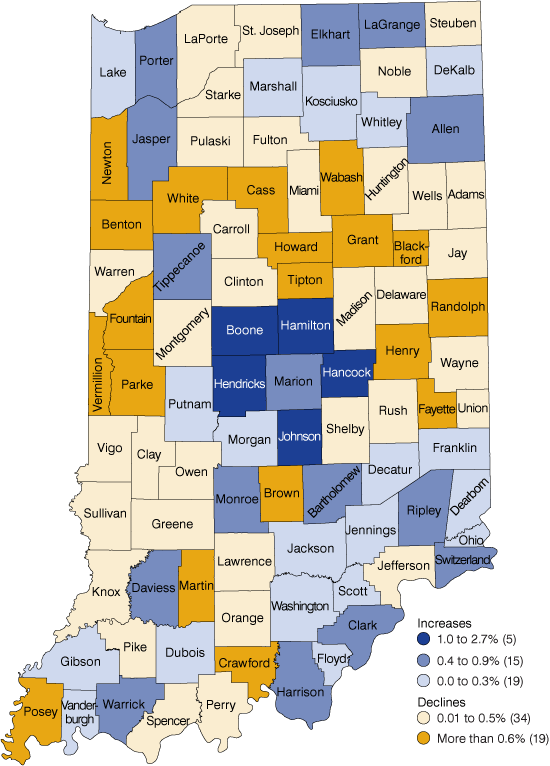
Source: Indiana Business Research Center
Overall, there are distinct geographic patterns in projected labor force growth across the state. Central Indiana will show strong gains in this decade, spearheaded by suburban counties around Indianapolis. Most counties in the southeastern portion of the state will also add workers, as will many counties linked to the Chicago area, Fort Wayne, Elkhart and Evansville. Meanwhile, the largest losses are expected throughout the north-central and east-central regions of the state. Furthermore, all western Indiana counties that are between the Evansville and Chicago metro areas are expected to lose labor force by 2020.
Implications of these Labor Force Trends
The dramatic demographic and labor force shifts expected over the next few decades raise plenty of concerns. The most obvious one relates to meeting the needs of a rapidly expanding group of retirees. Figure 10 shows that Indiana’s economic dependency ratio—the size of the population not in the labor force relative to the population that is in it—will climb over the next 30 years. In 2010, there were 99 Hoosiers not in the labor force for every 100 residents in the labor force. This mark should climb to 116 per 100 workers by 2040. While Indiana has had higher dependency ratios that dependency was weighted much more toward children in the past than it will be in the future. Research suggests that retirees have higher consumption needs than children do, driven primarily by health care costs.7
Figure 10: Indiana's Economic Dependency Ratio, 1940 to 2040
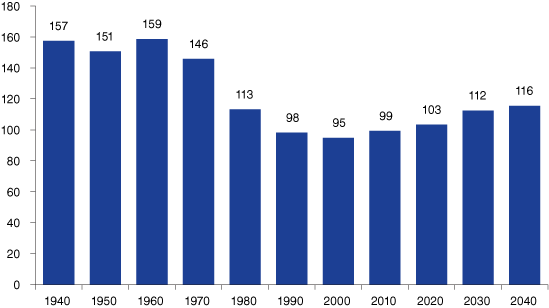
Note: The dependency ratio is expressed as number of residents not in the labor force for every 100 residents in the labor force.
Source: U.S. Census Bureau and Indiana Business Research Center
So how will a slowly growing labor force support the needs of a rapidly expanding group of retirees while continuing to improve (or at least maintain) living standards? The key will be continued productivity gains. According to a paper by Jane Little and Robert Triest at the Federal Reserve Bank of Boston, the U.S. will need something like a 40 percent increase in productivity between the mid 2000s and the mid 2030s to maintain current living standards.8 As the authors point out, this is a manageable target given historic trends. According to BLS, labor productivity in the U.S. has increased by 85 percent over the past 30 years, and their analysts project a 22 percent gain in productivity between 2010 and 2020.9
What’s more, Little and Triest discuss several studies that demonstrate a fairly strong negative relationship between growth of the working age population and productivity gains. That is, when the working age population is growing slowly, productivity gains tend to accelerate and vice versa. If this relationship holds, our demographic shifts may force employers to invest in even greater productivity gains in the coming decades.
Little and Triest note that one key to strong productivity growth in the future will be continued improvements in the skills and educational attainment of the labor force. However, labor force growth in years prior to the Great Recession was fueled in part by immigrants with lower levels of educational attainment. This trend could continue once the economy is hitting on all cylinders again. Efforts to improve human capital will be important for all workers, but especially so for some recent immigrants and their children.
While expected productivity gains should help minimize the negative effects of a slowly growing labor force, some industries will still feel the pinch of a tight labor market. Fields that are expected to grow such as health care, business operations and information technology will certainly have to compete for labor. Additionally, more mature industries that will likely grow little or even decline in the next couple of decades could still have trouble maintaining an adequate workforce because they are more dependent on older workers.
Table 2 highlights some of Indiana’s larger industries that are relatively reliant on baby boomers. For the most part, Indiana’s manufacturers are the most likely to employ an older workforce, although some service industries such as utilities, truck transportation, insurance carriers and wholesale trade are also dependent on baby boomers.
Table 2: Indiana Industries Dependent on Older Workers
| Industry | Total Employment | Percent of Employees Age 45 to 64 |
|---|---|---|
| Utilities | 15,287 | 59.0% |
| Primary Metal Manufacturing | 42,783 | 55.0% |
| Chemical Manufacturing | 28,388 | 54.4% |
| Truck Transportation | 49,861 | 53.7% |
| Nonmetallic Mineral Product Manufacturing | 11,976 | 53.1% |
| Computer and Electronic Product Manufacturing | 18,714 | 52.1% |
| Paper Manufacturing | 10,326 | 50.3% |
| Machinery Manufacturing | 36,489 | 48.8% |
| Printing and Related Support Activities | 17,174 | 48.3% |
| Insurance Carriers and Related Activities | 39,639 | 47.1% |
| Furniture and Related Product Manufacturing | 20,059 | 46.4% |
| Miscellaneous Manufacturing | 28,935 | 46.0% |
| Fabricated Metal Product Manufacturing | 51,561 | 45.6% |
| Transportation Equipment Manufacturing | 98,282 | 45.5% |
| Wholesale Trade | 116,910 | 45.3% |
| All Industries | 2,336,596 | 38.3% |
Note: Figures are a 4 quarter average from 2010:4 to 2011:3. Only industries with more than 10,000 workers are displayed.
Source: U.S. Census Bureau, Local Employment Dynamics
According to the Bureau of Economic Analysis, Indiana’s employment levels in all but three of the industries listed in this table declined between 2001 and 2011. Only truck transportation, insurance carriers and miscellaneous manufacturing (this industry includes medical equipment and device makers) are both growing and have a workforce that is skewed toward older workers, which suggests that these industries may need to be especially aggressive in attracting labor in the future. In shrinking industries, higher rates of retirement may not affect employers that will likely reduce payrolls in the future anyway. Other employers, however, may need to replace some retirees, even if the overall size of their payrolls will shrink. Further research is needed to identify which Indiana industries (and which occupations within those industries) may face a labor shortfall in the next couple of decades.
Even in today’s slack labor market, some firms are already taking action to address shortages. The Indianapolis-based trucking company Celadon, for instance, has recently opened its own certified driving school to help prepare new employees and is pursuing productivity gains through more efficient delivery routes and company processes. Similarly, Dot Foods’ Cambridge City distribution center recently opened a satellite location in Indianapolis to tap into a larger labor supply and now offers more flexible scheduling in an effort to attract more drivers.10 Among Hoosier manufacturers, Warsaw’s orthopedics industry recently partnered with its local Ivy Tech campus to develop the Orthopedic Quality Standards and Technical Skills Certificate Program, which is designed to quickly align the skills of job seekers with the needs of local employers.11
These are just a few examples of how firms can respond to a tight labor market in the future. Employers could also increase the number of hours worked by existing employees or loosen hiring requirements. Finally, many employers will have to raise wages to attract the workers they need.12 Higher wages could help stem the flow of retirements, attract workers from other fields, and encourage those outside the labor force (i.e., students) or those that are underemployed to prepare for a career in these fields.13
About the Projections
The primary data inputs for the labor force projections presented in this article are the IBRC’s population projections, which were released in March 2012, and age-specific LFPRs for the state and each county from the Census Bureau’s 2010 American Community Survey. Changes in the future path of age-specific LFPRs are based on projected shifts at the national level from the BLS’s most recent long-range projections.
As projections, these numbers simply reflect the labor force changes we can expect if past trends continue into the future. There are many factors, however, that could alter these expected trends. Probably the variable that is most sensitive to change is the LFPR. The LFPR in the younger age groups, for instance, is very low right now and is projected to remain that way. However, a strong economy with a tight labor market could draw more young workers into the labor force. Similarly, a variety of factors could force the LFPR for older workers to rise even more than expected.
Migration is another variable that is important to future labor force trends but is susceptible to large swings and is difficult to project. Strong economic growth and tight labor market could spur a greater than expected net in-migration to Indiana in the coming decades. Or, in the other direction, Indiana could experience periods of net out-migration like one it saw during the 1970s and 1980s.
To access the entire labor force projection data set or to read a detailed methodology, visit the Indiana Department of Workforce Developments data site at www.hoosierdata.in.gov/labor_proj/.
Notes
- The labor force is defined as all persons that are employed or those that are unemployed but looking for work.
- For more information on population projections for Indiana, visit www.stats.indiana.edu/topic/projections.asp.
- Mitra Toossi, “A New Look at Long-Term Labor Force Projections to 2050,” Monthly Labor Review, November 2006.
- Jessie Romero, “Where Have All the Workers Gone?” Region Focus, Federal Reserve Bank of Richmond, Second/Third Quarter 2012.
- “The Great Migration, 1910 to 1970,” U.S. Census Bureau, last modified September 13, 2012, www.census.gov/dataviz/.
- Matt Kinghorn, “Migration Trends and Population Change Between the Censuses,” Indiana Business Review, Fall 2011, www.ibrc.indiana.edu/ibr/2011/fall/article2.html.
- David M. Cutler, James M. Poterba, Louise M. Sheiner and Lawrence H. Summers, “An Aging Society: Opportunity or Challenge?,” Brookings Papers on Economic Activity, The Brookings Institution, 1990.
- Jane Sneddon Little and Robert K. Triest, “The Impact of Demographic Change on U.S. Labor Markets,” New England Economic Review, Federal Reserve Bank of Boston, First Quarter 2002.
- Kathryn J. Byun and Christopher Frey, “The U.S. Economy in 2020: Recovery in Uncertain Times,” Monthly Labor Review, January 2012.
- Shari Held, “Indy-Area Trucking Companies Getting Creative to Get Drivers,” Indystar.com, October 15, 2012.
- “Initiative Targets Ortho Work Force,” Inside Indiana Business, April 6, 2012.
- “Robert I. Lerman and Stefanie R. Schmidt, “An Overview of Economic, Social, and Demographic Trends Affecting the U.S. Labor Markets,” The Urban Institute, 1999.
- Linda Levine, “Retiring Baby-Boomers = A Labor Shortage?” CRS Report for Congress, Congressional Research Service, January 2008.
Matt Kinghorn
State Demographer, Indiana Business Research Center, Indiana University Kelley School of Business
